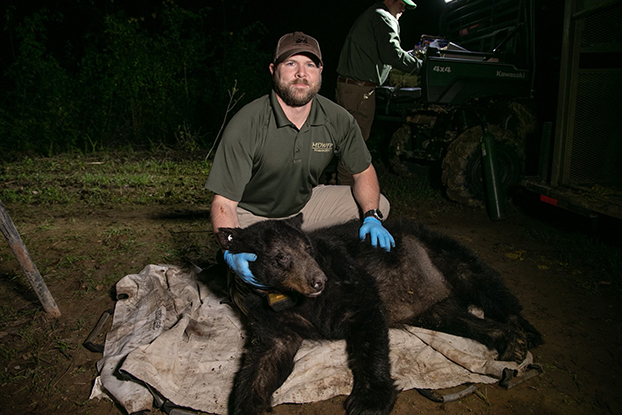Bear week busts myths
Published 5:44 pm Monday, May 6, 2024

- Mississippi Department of Wildlife, Fisheries and Parks Bear Program coordinator Anthony Ballard collared this female bear in Jefferson County this month. It was initially collared by Louisiana Department of Wildlife and Fisheries in Tensas Parish. The bear will collect data for ongoing research projects. (Submitted Photo | MDWFP Bear Program)
JACKSON — Summer is the start of when black bears move out of their normal home ranges and cover long distances to both mate and find new home ranges. Mississippi Department of Wildlife, Fisheries and Parks is hosting Bear Week on Facebook, Twitter and Instagram to educate the public about the native bears.
Black Bears are native to Mississippi and the population is starting to grow. Most bear sightings are in June, July and August when bears are on the move. Anthony Ballard serves as the Bear Program Director for MDWFP and said this year is the second year for bear week.
“Bear week started last year organically. We are spending a week focused on research and relay what research we are doing and highlight facts about bears,” Ballard said. “It will continue to be planned. This year, we had introductory videos made. We had a lot more work. There will be more animations throughout the week. Biological information about bears including how we gauge condition and age and some other fun things people can participate in.”
Ballard said the bear program will be featured in a podcast episode on Mississippi Outdoors hosted by Matt Wyatt. The episode will be recorded on May 14.
Myth busting
One myth is the MDWFP stocked and is currently stocking the black bear population in Mississippi. This is not entirely true, MDWFP stated it tried to restock the population in 1934 but was unsuccessful. The current population is due to natural expansion of Louisiana and Arkansas bear populations along the river. A small population of bears were left in Mississippi when the bear program was started.
Another myth is there is a smaller species of bear in Mississippi called “Sugar Bears.” Only two subspecies of black bears are native to Mississippi. MDWFP states these subspecies are the American Black bear and Louisiana black bear. The agency reported it is possible people mistook juvenile bears for another species.
As the summer approaches, people start to worry when they see bears in their backyards or around town as they move to find breeding opportunities or young males look for new home ranges. One myth is black bears are dangerous and aggressive. MDWFP states while any wild animal could be dangerous, black bears tend to avoid conflict with humans and attacks on people, livestock and pets are rare.
MDWFP conducts den checks in the winter to get a good snapshot of the population. While bears spend time in dens, they do not truly hibernate contrary to a myth that black bears hibernate in Mississippi. Bears go into a state of lethargic rest known as torpor.
People might believe a myth that black bears are solely meat eaters. Meat makes up for less than 10 percent of a black bear’s diet. On the occasion a bear eats meat it is usually carrion, animal carcasses.
Researching the bears
Mississippi State University and MDWFP are working on an ongoing research project with the black bear population. Last year, the bear program collared 24 bears with GPS collars to collect data on sex, age, distance range and to see if they crossed roadways. Gracious landowners helped with the project.
Social Media is one way the agency is working to educate the public about Mississippi’s black bear population.
Since 2016, 556 bear sightings have been reported to the MDWFP. Ballard said last year this was due to better public awareness. Three of the bear sightings were in Lincoln County. People can visit the MDWFP Bear Program page to see an interactive map showing sightings. The program page offers a way to report sightings online.





